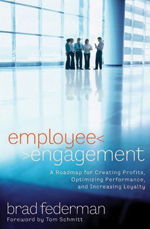 Employee Engagement: A Roadmap for Creating Profits, Optimizing Performance and Increasing Loyalty (Jossey-Bass, 2009) by Brad Federman, MEd’93. There is mounting evidence that employee engagement keenly correlates to individual, group and corporate performance in areas such as retention, productivity, customer service and loyalty. This book provides a comprehensive framework, language and process offering a research-based blueprint for looking at employee engagement with the same regularity and importance as any other aspect of the organization.
Employee Engagement: A Roadmap for Creating Profits, Optimizing Performance and Increasing Loyalty (Jossey-Bass, 2009) by Brad Federman, MEd’93. There is mounting evidence that employee engagement keenly correlates to individual, group and corporate performance in areas such as retention, productivity, customer service and loyalty. This book provides a comprehensive framework, language and process offering a research-based blueprint for looking at employee engagement with the same regularity and importance as any other aspect of the organization.
 Leading Schools During Crisis (Rowman Littlefield Education, 2009) by Matthew J. Pepper, MA’04, EdD’07; with Tim London, EdD’07; Mike Dishman, EdD’07; and Jessica King Lewis, BA’03, EdD’07. Analyzing the leadership and behaviors of principals who face situations threatening the continuing existence of their school, this scholarly and practice-oriented book proposes the first school-specific model of defining and analyzing crises. Through authentic case studies, it offers a detailed theoretical and practical analysis of each crisis and the lessons from it for all school leaders.
Leading Schools During Crisis (Rowman Littlefield Education, 2009) by Matthew J. Pepper, MA’04, EdD’07; with Tim London, EdD’07; Mike Dishman, EdD’07; and Jessica King Lewis, BA’03, EdD’07. Analyzing the leadership and behaviors of principals who face situations threatening the continuing existence of their school, this scholarly and practice-oriented book proposes the first school-specific model of defining and analyzing crises. Through authentic case studies, it offers a detailed theoretical and practical analysis of each crisis and the lessons from it for all school leaders.
 Surveillance in the Time of Insecurity (Rutgers University Press, 2010) by Torin Monahan, associate professor of human and organizational development and medicine. By exploring the counterterrorism-themed television show 24, rapture fiction, traffic control centers, security conferences, identity theft, public housing and gated communities and examining how each manifests complex relationships of inequality, insecurity and surveillance, Monahan fuses advanced theoretical accounts of state power with research from the social settings in which insecurity dynamics play out.
Surveillance in the Time of Insecurity (Rutgers University Press, 2010) by Torin Monahan, associate professor of human and organizational development and medicine. By exploring the counterterrorism-themed television show 24, rapture fiction, traffic control centers, security conferences, identity theft, public housing and gated communities and examining how each manifests complex relationships of inequality, insecurity and surveillance, Monahan fuses advanced theoretical accounts of state power with research from the social settings in which insecurity dynamics play out.
 Observational Measurement of Behavior (Springer Publishing Company, 2010) by Paul Yoder, MS’79, professor of special education, and Frank Symons, director of the Observational Methods Lab in the College of Education and Human Development at University of Minnesota. Focusing on both group and single-subject research design, it is intended as a text for graduate school courses that teach students how to conduct research using both types of designs. The book also addresses methods now enabled by computer software that many older texts do not address.
Observational Measurement of Behavior (Springer Publishing Company, 2010) by Paul Yoder, MS’79, professor of special education, and Frank Symons, director of the Observational Methods Lab in the College of Education and Human Development at University of Minnesota. Focusing on both group and single-subject research design, it is intended as a text for graduate school courses that teach students how to conduct research using both types of designs. The book also addresses methods now enabled by computer software that many older texts do not address.